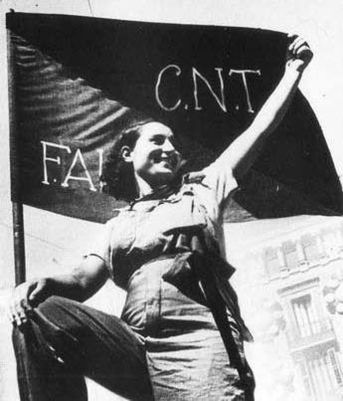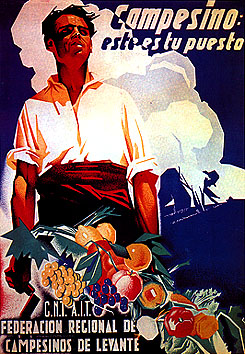 This week celebrates the 80th anniversary of the birth of the Spanish Civil War and Revolution, the momentous end to some six to seven decades of radical worker organizing, equal parts vibrant and brutally violent and inspired by the emissary of Mikhail Bakunin, Giuseppi Fanelli, in his visit to the country in 1868. As those familiar with the period will recall, the failure of fascist army general Fransisco Franco’s attempted military coup on 18 July 1936 plunged the nation into civil war as workers from the numerous union confederations and political parties offered open resistance, the parts of the country where the coup failed becoming virtually stateless as the army was defeated.
This week celebrates the 80th anniversary of the birth of the Spanish Civil War and Revolution, the momentous end to some six to seven decades of radical worker organizing, equal parts vibrant and brutally violent and inspired by the emissary of Mikhail Bakunin, Giuseppi Fanelli, in his visit to the country in 1868. As those familiar with the period will recall, the failure of fascist army general Fransisco Franco’s attempted military coup on 18 July 1936 plunged the nation into civil war as workers from the numerous union confederations and political parties offered open resistance, the parts of the country where the coup failed becoming virtually stateless as the army was defeated.
Having scarpered as their traditional form of protection melted away to nothing, the economically privileged classes left the way open for the national unions, the largest of which being the Confederacion Nacional del Trabajo (CNT), to take over, which they assuredly began to do the following day, 19 July. The CNT in particular seized the opportunity with relish, collectivising thousands of factories and business throughout the western regions of Spain — a period made most famous by George Orwell in Homage to Catalonia, who described his arrival in Barcelona in the following terms:
The Anarchists were still in virtual control of Catalonia and the revolution was still in full swing . . . It was the first time that I had ever been in a town where the working class was in the saddle. Practically every building of any size had been seized by the workers and was draped with red flags or with the red and black flag of the Anarchists; every wall was scrawled with the hammer and sickle and with the initials of the revolutionary parties;
Orwell took some pains to describe the cultural and economic changes that had taken place with the advent of workers’ self-management and economically democratic modes of production and distribution, noting that ‘Every shop and cafe had an inscription saying that it had been collectivised; even the bootblacks had been collectivized and their boxes painted red and black.’
Waiters and shop-walkers looked you in the face and treated you as an equal. Servile and even ceremonial forms of speech had temporarily disappeared. Nobody said ‘Sen~or’ or ‘Don’ ort even ‘Usted’; everyone called everyone else ‘Comrade’ or ‘Thou’, and said ‘Salud!’ instead of ‘Buenos dias’. Tipping had been forbidden by law since the time of Primo de Rivera; almost my first experience was receiving a lecture from a hotel manager for trying to tip a lift-boy. There were no private motor-cars, they had all been commandeered, and the trams and taxis and much of the other transport were painted red and black. The revolutionary posters were everywhere, flaming from the walls in clean reds and blues that made the few remaining advertisements look like daubs of mud. Down the Ramblas, the wide central artery of the town where crowds of people streamed constantly to and fro, the loud-speakers were bellowing revolutionary songs all day and far into the night. And it was the aspect of the crowds that was the queerest thing of all. In outward appearance it was a town in which the wealthy classes had practically ceased to exist.
He goes on to note that along with all the other changes, conspicuous consumption in the form of expensive clothing had disappeared; ‘Practically everyone wore rough working-class clothes, or blue overalls or some variant of militia uniform . . . All this was queer and moving.’ While in all of what he described Orwell found ‘much in this that I did not understand, in some ways I did not not even like it, but I recognized it immediately as a state of affairs worth fighting for.’
 This state of affairs that Orwell found so strange, moving and worth fighting for was eventually betrayed and destroyed by Spanish Stalinists in a manner conspicuously at odds with the containment doctrine that would arise in the United States ten or fifteen years later. In the meantime, it became the largest experiment in economic democracy and workers’ self-management of production history has ever known. Murray Bookchin wrote of the agrarian collectives that they ‘reflected to a remarkable extent the organizational forms which the anarchists fostered among all the villages under their influence before the 1936 revolution.’
This state of affairs that Orwell found so strange, moving and worth fighting for was eventually betrayed and destroyed by Spanish Stalinists in a manner conspicuously at odds with the containment doctrine that would arise in the United States ten or fifteen years later. In the meantime, it became the largest experiment in economic democracy and workers’ self-management of production history has ever known. Murray Bookchin wrote of the agrarian collectives that they ‘reflected to a remarkable extent the organizational forms which the anarchists fostered among all the villages under their influence before the 1936 revolution.’
The revolution in rural communities essentially enlarged the old IWMA and later CNT nuclei, membership groups, or quite simply clans of closely knit anarchist families into popular assemblies. These usually met weekly and formulated the policy decisions of the community as a whole. The assembly form comprised the organizational ideal of village anarchism from the days of the first truly Bakuninist congress of the Spanish IWMA in Córdoba in 1872, stressing the libertarian traditions of Spanish village life. Where such popular assemblies were possible, their decisions were executed by a committee elected from the assembly. Apparently, the right to recall committee members was taken for granted and they certainly enjoyed no privileges, emoluments, or institutional power. Their influence was a function of their obvious dedication and capabilities. It remained a cardinal principle of Spanish anarchists never to pay their delegates, even when the CNT numbered a million members. Normally, the responsibilities of elected delegates had to be discharged after working hours.
Such radical forms of direct democracy organised through popular assemblies formed a crucible for numerous other changes, not least of which being in regards to the status of women.
With all its limitations, the Spanish Revolution in its first phase brought new possibilities for women . . . One group which attempted to get a libertarian perspective on the situation was Mujeres Libres (Free Women) . . . The federation grew, organising for women to make the maximum contribution to whatever practical work had to be done. Its members saw themselves as having an important educational function, working to emancipate women from the traditional passivity, ignorance and exploitation that enslaved them, and towards a teal understanding between men and women, who would work together without excluding each other.
Research into the history not only of the Spanish Civil War but of its revolutionary elements has developed significantly over the last few decades, not least due to the translation of crucial works by Jose Pierats and Frank Mintz on the workers movements and the collectives into English. Such help to round out the picture available to us from previous research and other sources of information like the Living Utopia documentary, a well as a a 6-part documentary series from the BBC.
In this day and age where corporate capture of capitalist democracy has become so complete that the two-party system seems only to reflect political divisions within Goldman Sachs, the example of worker self-management and economic democracy from this great period in history serve to remind us that other worlds are possible. The courageous anti-fascists of Spain may well have lost the war, but they sure as hell won the revolution, demonstrating in the process the power and capacity of regular people to take control of the conditions of our own work and our own lives and run them just as effectively as our purported representatives — if not vastly more so.
No pasaran!
Discover more from Ben Debney
Subscribe to get the latest posts sent to your email.

